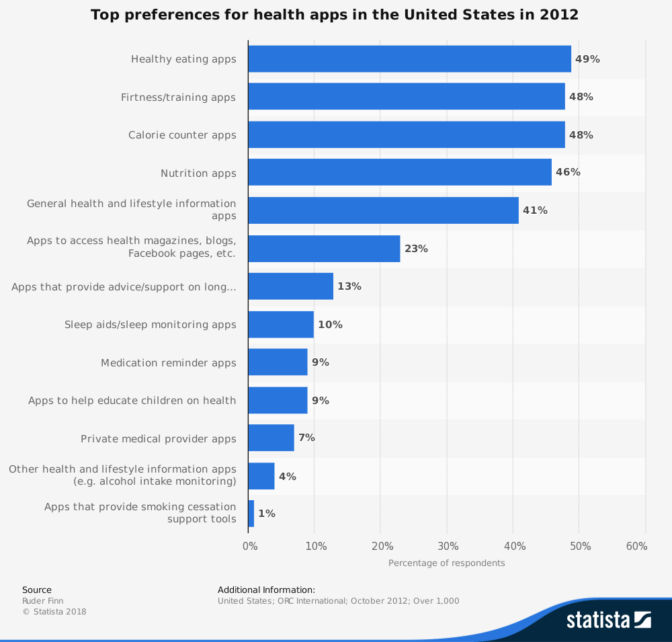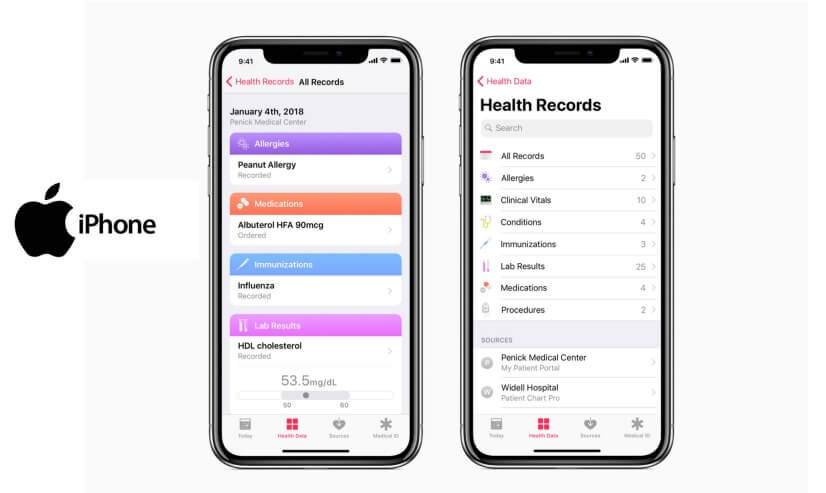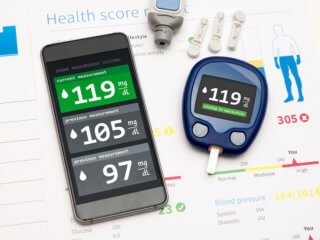Apple targets mHealth market by adding medical records feature to iPhone
The new medical records feature of Apple uses the existing medical app to aid medical centres to connect through the API to their EMR system. The Electronic medical record (EMR) is a digital copy of a physical document with all of a patient’s medical history and transfer data between patients and medical institutions. A few years ago, medical records of patients were held in several places, which required patients to log into every Medicare provider’s website and piece to get their information manually.
This service prompted Apple to create Fast Healthcare Interoperability Resources (FHIR), as an advanced way for customers to get all their medical records transferred electronically from their iPhone. This transfer will be done by updating the health app with iOS 11. 3 beta for iPhone and Apple Watch owners.
This will link medical centres with the existing Health app, and make it easier for consumers to see their medical information from various providers whenever they choose.
With the updated iOS 13 app, consumers will access their medical data from different institutions organized into a single view. This medical health record app will cover the following data:
- General health history
- Immunizations records
- Prescription drug supplies and refill
- Laboratory test results
- Allergies
- Medications
- Clinical vitals.
An existing health app on the iPhone can be upgraded via a wireless connection to enjoy monitoring, storage of medical data and notifications of successful data upload. Medical records data is encrypted and protected with the user’s iPhone passcode.
The medical records like other data on your iPhone, are encrypted and are not stored in Apple’s cloud server except if you choose to store via iCloud. All your medical records are well secured with a passcode, TouchID or a Face ID on your iPhone.
What does it mean for the digital health sector?
The introduction of an app that focuses on daily health with iOS 11 puts affordable reality into the hands of hundreds of millions of iPhone users. The medical record feature brings seamless advantage for millions of iPhone users who need medical attention faster than before.
The most recent data available show that there are 85.5 million iPhone owners in the United States, and a market share of 52.3 percent of phone users in Canada and the U.S. In the year 2013, there were over 40,000 medical-related apps available in the iTunes store for download. As capitalism plays a major goal in Apple business strategy with the medical record app, the $3 trillion enterprise health sector is Apple’s interest.

Image courtesy of Statista
The new medical health app is a landslide achievement in the health sector because of a larger number of patients that are iPhone users who can link their digital health information with respective health care providers. A large portion of the population will have an improved app that requires wireless connectivity to be interactive. For patients, Apple has made it seamless to use the iOS 11.3 public beta software for an upgrade.
The plan is to allow the user access to all their relevant medical records in one system, the iPhone (or iPod Touch). These medical records include hospital appointments, laboratory test results, immunizations, allergies, vitals, medications, and so on. Apple thought it wise to use this medical app for partnership with Stanford University School of Medicine survey.
The survey requires an improvement of the iWatch’s heart rate sensor. The Apple Watch will collect data on abnormal heart rhythms for the researchers. Healthcare providers can use the iOS 11.3 apps to access confidential health information of their patients before they visit the clinics.
Also, via a PCI-compliant payment service from TrustCommerce, the providers can set up billing systems for their patients. According to Apple, for now, the new medical record feature is open to the patients of 12 hospital systems.
However, there is a risk of an increase in health insurance fees as insurance companies would want to optimize their business decision if they can access confidential medical records for millions of subscribed users. Here is a list of the 12 hospitals with the iPhone medical records feature.
- John Hopkins Medicine – Baltimore
- Cedars-Sinai – Los Angeles
- Penn Medicine – Philadelphia
- Geisinger Health System – Danville, Pa.
- UC San Diego Health – San Diego
- UNC Health Care – Chapel Hill, NC
- Rush University Medical Center – Chicago
- Dignity Health – Arizona, California and Nevada
- Ochsner Health System – Jefferson Parish, La.
- MedStar Health – Washington, D.C., Maryland and Virginia
- OhioHealth – Columbus
- Cerner Health Clinic – Kansas City, Mo
What is there to add in future?
In the coming years, Apple might need to share a high-encrypted network with their health app partners. This idea to secure users’ details is necessitated by the recent hack of private medical records at a medical facility. In current medical records feature, you don’t have your medical records under your purview.
Other functions to be added which are being recorded in other EHRS solutions is the plan for Apple to permit hospitals, clinics, and other healthcare services a self-registration. This self-registration method will eliminate middlemen and Apple agents.
The iOS health app is certainly not the only top-rated medical feature that gives consumers an interface with healthcare providers. There are Android-based medical apps with user-friendly features, but the usability is not as wide as the Apple’s. More so, on medical record features on Android device does not have sleek designs and sensitive features like heartbeat rate, good and bad cholesterol trackers, etc. In contrast with Apple’s iOS, the Android OS is very dynamic because consumers can license this Android operating software with any device they prefer.
However, the Android OS gives numerous app vendors and Smartphone manufacturers the ease to resolve hardware issues. This seamless resolution occurs by swapping the Android device whenever there is a serious hardware problem. Also, a user’s data with the Android health app can be transferred to another device without a necessary upgrade.
This process of a device and medical data swap is not possible without an upgrade on the iOS. There has been a case of a cyber-attack on consumers’ private records; this cybercrime was not from the manufacturer’s end but from the inefficiency of the medical facility.
Apple boasts of a highly encrypted network and guarantees safety for consumer’s record.. Therefore, the medical records feature on the Apple health app is better and more secure than the Android version.
With the launch of the Health Kit platform and Health app in 2014, the healthcare system has enjoyed a digital interface with millions of patients. The cutting-edge technology from Apple helps patients transfer their medical records and pay for health services on-the-go. With an increase in medical transaction and update, the CEO of Apple, Tim Cook said America’s health sector is moving up to become the largest part of the U.S economy. This is a transformation that will be expanded to accommodate more healthcare providers and create jobs in the nearest future.
Conclusion
Apple’s improved health app focuses on obtaining data from other applications to give some seamless analytics in the healthcare industry. However, the Google fit health app does not enjoy a seamless interface with the healthcare industry. Also, Apple health (Health post-iWatch and Health now) keeps a complete medical record in the hospital’s archives, whereas the Google fit doesn’t offer much medical records storage. The improved technological features with Apple health app makes it a preferred choice.
Image credit: Apple

















